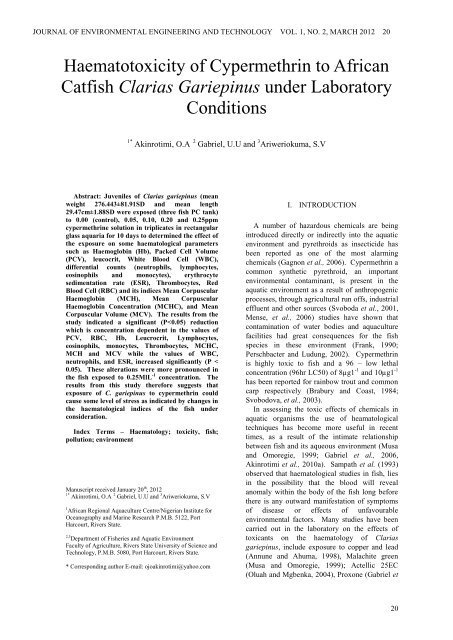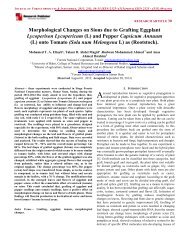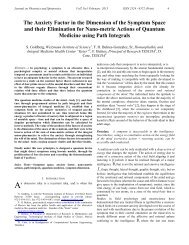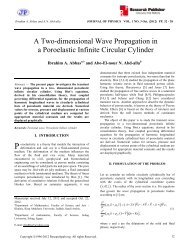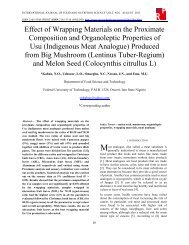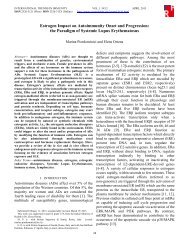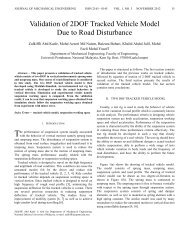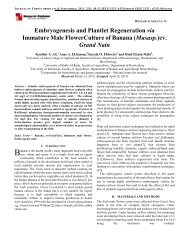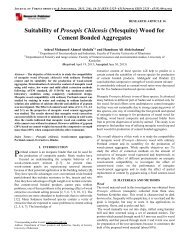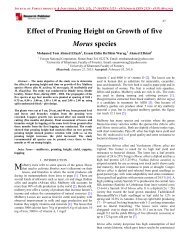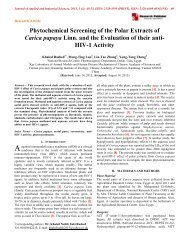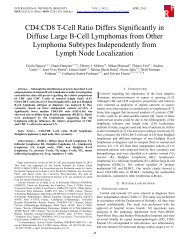Haematotoxicity of Cypermethrin to African Catfish Clarias ...
Haematotoxicity of Cypermethrin to African Catfish Clarias ...
Haematotoxicity of Cypermethrin to African Catfish Clarias ...
- No tags were found...
You also want an ePaper? Increase the reach of your titles
YUMPU automatically turns print PDFs into web optimized ePapers that Google loves.
JOURNAL OF ENVIRONMENTAL ENGINEERING AND TECHNOLOGY VOL. 1, NO. 2, MARCH 2012 20<strong>Haema<strong>to</strong><strong>to</strong>xicity</strong> <strong>of</strong> <strong>Cypermethrin</strong> <strong>to</strong> <strong>African</strong><strong>Catfish</strong> <strong>Clarias</strong> Gariepinus under Labora<strong>to</strong>ryConditions1* Akinrotimi, O.A 2 Gabriel, U.U and 3 Ariweriokuma, S.VAbstract: Juveniles <strong>of</strong> <strong>Clarias</strong> gariepinus (meanweight 276.443±81.91SD and mean length29.47cm±1.88SD were exposed (three fish PC tank)<strong>to</strong> 0.00 (control), 0.05, 0.10, 0.20 and 0.25ppmcypermethrine solution in triplicates in rectangularglass aquaria for 10 days <strong>to</strong> determined the effect <strong>of</strong>the exposure on some haema<strong>to</strong>logical parameterssuch as Haemoglobin (Hb), Packed Cell Volume(PCV), leucocrit, White Blood Cell (WBC),differential counts (neutrophils, lymphocytes,eosinophils and monocytes), erythrocytesedimentation rate (ESR), Thrombocytes, RedBlood Cell (RBC) and its indices Mean CorpuscularHaemoglobin (MCH), Mean CorpuscularHaemoglobin Concentration (MCHC), and MeanCorpuscular Volume (MCV). The results from thestudy indicated a significant (P
JOURNAL OF ENVIRONMENTAL ENGINEERING AND TECHNOLOGY VOL. 1, NO. 2, MARCH 2012 21al., 2006), Monocro<strong>to</strong>phous (Yaji and Auta,2007), Kerosene (Gabriel et al., 2007). Thesestudies showed that various degrees <strong>of</strong>haema<strong>to</strong>logical changes could be produced byexposure <strong>of</strong> C. gariepinus <strong>to</strong> different levels <strong>of</strong><strong>to</strong>xicants under labora<strong>to</strong>ry conditions.Despite a number <strong>of</strong> studies on the effects <strong>of</strong><strong>to</strong>xicants on haema<strong>to</strong>logy <strong>of</strong> C. gariepinus littleis known on the haema<strong>to</strong>logical changes that C.gariepinus may suffer under exposure <strong>to</strong>cypermethrin, a pesticide commonly applied inagriculture operations. The present study wascarried out <strong>to</strong> assess the effect <strong>of</strong> exposure <strong>of</strong> C.gariepinus <strong>to</strong> cypermethrin on its haema<strong>to</strong>logicalparameters under labora<strong>to</strong>ry conditions.II. MATERIALS AND METHODSA <strong>to</strong>tal <strong>of</strong> 18 <strong>Clarias</strong> gariepinus (mean bodyweight 276.44g ±8190SD and mean <strong>to</strong>tal length29.47cm±1.88SD) were obtained from a privatefarm <strong>of</strong> Abuloma Town in Port Harcourt LocalGovernment Area <strong>of</strong> Rivers State in Nigeria.They were then transported in plastic aquaria <strong>to</strong>the fisheries research labora<strong>to</strong>ry <strong>of</strong> the RiversState University <strong>of</strong> Science and Technology, PortHarcourt, Nigeria. The fish were acclimated <strong>to</strong>labora<strong>to</strong>ry condition for a period <strong>of</strong> one week.During the exposure period, the fish were fed oncommercial diet (35%CP) once a day at 3% <strong>of</strong>their body weight.After the period <strong>of</strong> acclimation, the fish wererandomly distributed in<strong>to</strong> eighteen glass aquaria(56 x 28 x 28cm) with 30 litres <strong>of</strong> water at threefish per aquarium. Each <strong>of</strong> the aquaria containedeach <strong>of</strong> the following concentrations <strong>of</strong>cypermethrin: 0.05, 0.10, 0.15, 0.20 and 0.25ml/l. The control group <strong>of</strong> fish were kept inaquaria devoid <strong>of</strong> <strong>to</strong>xicant (0.00mlL -1 ) each <strong>of</strong>these treatments had three replicates. During theexposure period which lasted for 10days, somewater quality parameters namely pH,conductivity, dissolved oxygen, alkalinity andhardness were measured thrice using the methodsdescribed by APHA (1985). Fresh preparation <strong>of</strong>the test solution were introduced in<strong>to</strong> theexperimental media on daily basis.At the end <strong>of</strong> the experiment, blood wascollected from the fish by cardiac puncture usinga 21 – gauge hypodermic needle and syringe.The following haema<strong>to</strong>logical parametershaemoglobin (Hb), Packed Cell Volume (PCV),Red Blood Cell (RBC) and ErythrocyteSedimentation Rate (ESR), were determinedusing the methods described by Blaxhall andDaisley (1973). Differential counts (neutrophils,lymphocytes, eosinophils, monocytes) andleucorit were evaluated according <strong>to</strong> McLeay andGordon (1977). Red blood indices such as meancorpuscular haemoglobin concentration (MCHC),mean corpuscular haemoglobin (MCH), andMean Corpuscular Volume (MCV) werecalculated using the formula <strong>of</strong> Seiverd (1983).Data obtained from the study were analyzed bya one-way analysis <strong>of</strong> variance (ANOVA) test at0.05% probability level and differences amongmeans were indicated using Tukey test (Zar,1984).III. RESULTSThe water quality parameters in the varioustreatment levels (Table 1) showed that there wereno significant differences between the treatmentand the control. The haema<strong>to</strong>logical changesproduced by the effects <strong>of</strong> exposure <strong>of</strong> C.gariepinus <strong>to</strong> different levels <strong>of</strong> the pesticideunder daily renewal condition showed asignificant (p
JOURNAL OF ENVIRONMENTAL ENGINEERING AND TECHNOLOGY VOL. 1, NO. 2, MARCH 2012 22Table 1: Physio-Chemical Parameters <strong>of</strong> Exposure aquariaConc. Ofcypermethrin.(mlL -1 )pHConductivitys/cmDissolved(Oxygen)(mlL -1 )Alkalinity(mlL -1 )Hardness(mlL -1 )0.00 5.46±0.23 a 69.33±0.67 a 7.82±0.07 a 25.57±0.02 a 6.61±0.01 a0.05 6.07±0.27 a 69.75±0.75 a 7.50±0.30 a 24.48±0.28 a 6.07±0.03 a0.10 5.89±0.39 a 69.05±0.55 a 7.22±0.53 a 24.27±0.07 a 6.29±0.02 a0.15 5.87±0.45 a 70.15±0.55 a 7.08±0.42 a 24.16±0.41 a 6.04±0.01 a0.20 6.15±0.37 a 70.15±0.55 a 7.04±0.11 a 24.16±0.08 a 6.28±0.23 a0.25 6.06±0.41 a 69.80±0.56 a 6.85±0.56 a 24.77±0.58 a 6.36±0.05 aMean with the same superscript in the column are not significant different (P>0.05)22
JOURNAL OF ENVIRONMENTAL ENGINEERING AND TECHNOLOGY VOL. 1, NO. 2, MARCH 2012 23Table 2: Heama<strong>to</strong>logical responses <strong>of</strong> <strong>Clarias</strong> gariepinus in various concentrations <strong>of</strong> solution <strong>of</strong> cypermethrin for 10 days (Mean±SD)Conc. Of cypermethrin0.00 0.05 0.10 0.15 0.20 0.25(mlL -1 )PCV (%) 34.76±3.06 a 30.00±6.25 ab 28.33±4.73 b 25.33±5.13 ab 15.66±10.02 ab 8.67±0.58 cHb (g/dl) 11.57±1.03 a 9.97±2.08 ab 9.47±1.57 b 8.43±1.96 ab 8.43±3.37 ab 3.97±0.25 cLeucocrit (%) 4.18±0.00 ab 3.33±2.31 a 2.00±1.00 ab 1.33±0.58 ab 1.00±0.00 b 1.33±0.587 abWBC (x 10 9 cells) 5.43±2.61 a 5.53±1.79 ab 6.20±0.69 ab 7.03±3.33 ab 11.23±0.06 b 15.23±1.29 aNeutrophils (%) 21.67±2.89 a 22.67±7.51 a 23.33±11.55 c 24.67±7.64 d 25.33±7.64 c 26.00±1.00 fLymphocytes (%) 78.33±20.21 a 71.33±20.13 a 71.67±15.14 a 71.67±18.93 a 71.67±15.28 a 41.33±8.08 abEosinophils (%) 10.00±17.32 a 8.33±14.43 a 5.81±4.00 b 4.67±8.08 b 3.41±5.00 b 3.33±8.62 aMonocytes (%) 4.33±5.77 a 3.33±14.43 a 3.01±0.66 a 2.67±3.06 a 1.67±2.89 a 1.01±0.10 aESR (mm/h) 2.33±0.58 b 2.01±1.53 b 3.97±1.15 b 5.67±2.52 b 7.87±2.08 b 14.67±6.43 aThrombocyte (%) 132.67±31.64 ab 120.00±0.58 ab 110.00±138.92 a 98.33±38.19 b 86.67±12.58 ab 53.33±40.72 bRBC 7.32±1.01a 6.01±1.11b 5.24±1.10c 4.01±1.02 ab 3.66±0.86 d 2.98±0.74MCHC (g/dl) 33.00±0.00 a 32.33±0.58 ab 31.67±0.58 c 30.00±0.00 abc 29.00±0.00 a 22.00±0.58 bcMCH (pg) 32.33±0.58 a 31.67±0.58 a 31.67±0.58 a 31.67±0.58 a 32.00±1.00 a 31.33±0.58 aMCV (fl) 96.67±0.58 a 96.33±0.58 a 95.33±1.15 ab 96.00±1.00 ab 96.33±2.08 a 93.33±2.31 bMean with the same superscript in the column are not significantly different (P
JOURNAL OF ENVIRONMENTAL ENGINEERING AND TECHNOLOGY VOL. 1, NO. 2, MARCH 2012 24IV. DISCUSSIONThe water quality variables in the experimentaltanks were within the range acceptable foroptimum performance <strong>of</strong> fish in culture medium(Boyd, 1998). There was concentrationdependent reduction in the values <strong>of</strong> dissolvedoxygen levels in the exposure tanks, an indicationthat cypermethrin affects the dissolved oxygenconcentration during the experimental procedureresulting in asphyxiation. This result agreed withthe findings <strong>of</strong> Gabriel et al. (2006) in <strong>Clarias</strong>gariepinus exposed <strong>to</strong> proxone in the labora<strong>to</strong>ry.The haema<strong>to</strong>logical parameters in the controlgroup falls within the range <strong>of</strong> normal valuesreported for several cultured catfishes (Erondu etal., 1993: Ogbulie and Okpokwasili, 1999;Akinrotimi, 2008). Exposure <strong>of</strong> C. gariepinus <strong>to</strong>sublethal concentrations <strong>of</strong> cypermethrin caused asignificant decrease in the values <strong>of</strong> eosinophils,Hb, PCV, RBC, leucocrit, lymphocytes,monocytes and thrombocytes <strong>of</strong> the fish. Similarreductions were reported by some athors:Sampath et al. (1993) in Oreochromismossambicus exposed <strong>to</strong> OrganophosphorusOmoregie et al. (1994) in Oreochromis niloticusexposed <strong>to</strong> formalin, Svoboder et al. (2001) inCyprinus carpio exposed <strong>to</strong> diazinon and Gabrielet al. (2007) in C. gariepinus exposed <strong>to</strong> refinedcrude oil products kerosene. The reduction inRBC, Hb and PCV which are related <strong>to</strong> oxygencarrying capacity <strong>of</strong> the blood, may be due <strong>to</strong> theinhibition <strong>of</strong> erythropoiesis hemosynthesis, andincrease in the rate <strong>of</strong> erythrocyte destruction inhaemopoietic organs.Concentration dependent exposure <strong>of</strong> C.gariepinus <strong>to</strong> cypermethrin in this work caused areduction in the lymphocytes, leads <strong>to</strong>lymphopaenia, an indica<strong>to</strong>r <strong>of</strong> unfavourableenvironment, thus corroborating the reports <strong>of</strong>Oluah and Mgbeka (2004) in C. albopunctatusexposed <strong>to</strong> sublethal concentrations <strong>of</strong> actellic25EC. Also, in this work, the reduction observedin leucocrit which is the leucocyte, thrombocytespacked value expressed as a percentage <strong>of</strong> thewhole blood is comparable <strong>to</strong> that <strong>of</strong> Adhikari etal. (2004) in fresh water teleost, Labeo rohitaexposed <strong>to</strong> cypermethrin and cab<strong>of</strong>uran underlabora<strong>to</strong>ry conditions. This is an indication <strong>of</strong>incipient stressful conditions <strong>of</strong> the fish.The reduction in the values <strong>of</strong> eosinophils andmonocytes reported in this study is in agreementwith the findings <strong>of</strong> Benariji and Rajendranath(1990) in <strong>Clarias</strong> batrachus exposed <strong>to</strong>dichlorvos, but contrary <strong>to</strong> that <strong>of</strong> Velisek et al.(2007) in rainbow trout, after exposure <strong>to</strong>deltamethrin the disparity may be due <strong>to</strong> thedegree <strong>of</strong> potency <strong>of</strong> the <strong>to</strong>xicant and its mode <strong>of</strong>actions in different species <strong>of</strong> fish. The ESRvalue <strong>of</strong> fish exposed <strong>to</strong> cypermethrin increasedsignificantly when compared <strong>to</strong> control values.This corroborates the report <strong>of</strong> Svobodova et al.(2003) in Cyprinus Carpio treated withdeltamethrin. The increase ESR value may bedue <strong>to</strong> fragility <strong>of</strong> erythrocytes as a result <strong>of</strong> stressinduces disruptions in the formation and release<strong>of</strong> erythrocytes from haema<strong>to</strong>paetic tissues(Akinrotimi et al., 2010b).Another type <strong>of</strong> haema<strong>to</strong>logical response <strong>to</strong> theeffect <strong>of</strong> cypermethrin was a significantincrement in WBC. This response was equallyobserved in common carp Cyprinus carpio afteracute effect <strong>of</strong> phenitrothion, imidan anddichlorvos (Svobodova, 1991, 1996, 1998). Thismay be due <strong>to</strong> release <strong>of</strong> white blood cells fromspleen in<strong>to</strong> the blood stream <strong>to</strong> combat the<strong>to</strong>xicant.Alteration in the erythrocytes indices <strong>of</strong> C.garipienus, consequent <strong>of</strong> cypermethrinexposure, caused a non significant change withno definite trend, this is in line with theobservation <strong>of</strong> Tsuda et al. (2007) in killifishsubjected <strong>to</strong> organophosphorus insecticide in thelabora<strong>to</strong>ry.V. CONCLUSIONEvaluation <strong>of</strong> haema<strong>to</strong>logical parameters <strong>of</strong>fish exposed <strong>to</strong> <strong>to</strong>xicants in this study, providedvaluable information in the assessment <strong>of</strong> fishhealth and in moni<strong>to</strong>ring stress responses. Theexposure <strong>of</strong> C. gariepinus <strong>to</strong> sublethalconcentrations <strong>of</strong> cypermethrin caused markedvariations in the blood indices <strong>of</strong> the fish anindication that this chemical is highly <strong>to</strong>xic t<strong>of</strong>ish and its use should be controlled so as <strong>to</strong>prevent its entrance in<strong>to</strong> water bodies <strong>to</strong> minimizeaquatic pollution consequent <strong>of</strong> agrochemicals.REFERENCES[1] Adhikari, S., Sarkar B., Chatterjee, A., Mahapatra, C.T.and Ayyappan, S. Effects <strong>of</strong> cypermethrin andcarb<strong>of</strong>uran on certain haema<strong>to</strong>logical parameters andprediction <strong>of</strong> their recovery in a freshwater teleost Labeorohida. Eco<strong>to</strong>xicology and Environmental Safety. 2004.58:220 – 226.[2] Akinrotimi, O.A. Comparative haema<strong>to</strong>logy <strong>of</strong> someculturable clariids raised in freshwater tidal and stagnantearthen ponds. M.Sc Thesis submitted <strong>to</strong> theDepartment <strong>of</strong> Fisheries, Rivers State University <strong>of</strong>24
JOURNAL OF ENVIRONMENTAL ENGINEERING AND TECHNOLOGY VOL. 1, NO. 2, MARCH 2012 25Science and Technology, Port Harcourt, Rivers State,Nigeria. 2008. 103pp.[3] Akinrotimi, O.A., Abu, O.M.G., Agokei, E.O. andUedeme-Naa, B. Effects <strong>of</strong> direct transfer <strong>to</strong> fresh wateron the haema<strong>to</strong>logical parameters <strong>of</strong> Tilapia guineensis(Bleeker 1862). Animal Research International 2010a.7(2):1199-1205.[4] Akinrotimi, O.A., Uedeme-Naa, B. and Agokei, E.O.Effects <strong>of</strong> acclimation on haema<strong>to</strong>logical parameters <strong>of</strong>Tilapia guineensis (Bleeker 1862). Science WorldJournal 2010b. 5(4):1-4.[5] Annune, P.A. and Ahuma, F.T.A. Haema<strong>to</strong>logicalchanges in mudfish exposed <strong>to</strong> sublethal <strong>to</strong>concentrations <strong>of</strong> copper and lead. Journal <strong>of</strong> AquaticSciences 1998. 13:33 – 36.[6] APHA American Public Health Association. StandardMethod for the Examination <strong>of</strong> Water and Waste Water.(17 th edition). Washing<strong>to</strong>n D.C, U.S.A. 1985. 1391pp.[7] Benarji, G. and Rajendranath, T. Haema<strong>to</strong>logicalchanges induced by an organophosphorus insecticide ina freshwater fish <strong>Clarias</strong> batrachus. TropicalFreshwater Biology. 1990. 2:197-202.[8] Blaxhall, P.C. and Daisley, K.W. RoutineHaema<strong>to</strong>logical methods for use with fish blood Journal<strong>of</strong> Fish Biology. 1973. 5:771-781.[9] Boyd, C.E.. Water quality in warm water fish ponds.Aubun University Alabama. USA 1998. 122pp.[10] Bradbury, S.P. and Coast, J.R. Comparative <strong>to</strong>xicology<strong>of</strong> the pyrethroid insecticides. EnvironmentalContamination Toxicology 1989. 108:134 – 177.[11] Erondu, E.S., Nnubia, C. and Nwadukwe, F.O.Haema<strong>to</strong>logical Studies on Four <strong>Catfish</strong> species raisedin freshwater ponds in Nigeria. Ichthyology 1993. 805:1-6.[12] Frank, R. Contamination <strong>of</strong> rural ponds with pesticides.Canadian Bulletin Contamination Toxicology. 1990.44:401-409.[13] Gabriel, U.U. Ezeri, G.N.O., Ikeme, P.M. and Ikwut,E.F. Haema<strong>to</strong>xicity <strong>of</strong> proxone <strong>to</strong> juvenile <strong>Clarias</strong>gariepinus (Burchell, 1822) under labora<strong>to</strong>ry conditions.Pollution Research 2006. 25(2):1-6.[14] Gabriel, U.U., Amakiri, E.U. and Ezeri, G.N.O.Haema<strong>to</strong>logy and gill pathology <strong>of</strong> <strong>Clarias</strong> gariepinusexposed <strong>to</strong> refined petroleum oil under labora<strong>to</strong>ryconditions. Journal <strong>of</strong> Animal and Vetrinary Advances.2007. 6(3): 461-465.[15] Gagnon, A., Jumarie, C. and Hondela, A. Effects <strong>of</strong> Cuon plasma contisol and corrtisol secretion by adraanocoritical cells <strong>of</strong> rainbow trout. Aquatic Toxicology2006. 78:59-65.[16] McLeay, D.J. and Gordon, M.R. Leucocrit a simplehaema<strong>to</strong>logical technique for measuring acute stress insalmon fish, including stressful concentrations <strong>of</strong>pulpmill effluent. Journal <strong>of</strong> Fishery Research 1977.34:2164 – 2175.[17] Meise, S.M., Siengupta, A., Lan, C., Zhou M andZhang, L. The common insecticides <strong>of</strong> cyfluthrin andchlorpyrifor alter the expression <strong>of</strong> a subset <strong>of</strong> geneswith diverse functions in fish. Toxicology Science. 2006.93:125-135.[18] Musa, S.O. and Omoregie, E. Haema<strong>to</strong>logical changesin <strong>Clarias</strong> gariepinus exposed <strong>to</strong> malachite green.Journal <strong>of</strong> Aquatic Sciences. 1999. 14:37-42.[19] Ogbulie, J.N. and Okpokwasili, G.C.. Haema<strong>to</strong>logicaland his<strong>to</strong>logical responses <strong>of</strong> <strong>Clarias</strong> gariepinus andHeterobrancus bidorsalis <strong>to</strong> some bacterial diseases inRivers State, Nigeria. Journal Nature and Science. 1999.27(1):1-16.[20] Oluah, N.S. and Mgbenka, E.O. Effects <strong>of</strong> actellic 25ECon the leucocyte counts <strong>of</strong> the catfish, <strong>Clarias</strong>albopunctatus. Animal Research International 2004.1(1):52-56.[21] Omoregie, E., Eseyin, T.G. and Ofojekwu P.C. Chroniceffects <strong>of</strong> formalin on erythrocyte counts and plasmaglucose <strong>of</strong> Nile tilapia Oreochromis niloticus. AsianFisheries science 1994. 7:1-6.[22] Perschbacther, P. and Ludang, G. Herbicide drift andChannel <strong>Catfish</strong> ponds. World Aquaculture 2002. 33(4):24 – 26.[23] Sampath, K., Velamnia, S.K. and James, R.Haema<strong>to</strong>logical changes and their recovery inOreochromis mossambicus as a function <strong>of</strong> exposureperiod and sublethal levels <strong>of</strong> Elalus. ActaHydriobiology 1993. 35:73-83.[24] Seiverd, C.E. Haema<strong>to</strong>logy for medical Technologists.(3 rd edition). Lea and Febiger, Philadelphia, U.S.A.1983. 946pp.[25] Svoboda, M., Luskova, V., Drastichova, J. and Zlabek,V. The effect <strong>of</strong> diazinon on haema<strong>to</strong>logical indices <strong>of</strong>common carp Cyprinus carpio Acta Vetrinary Bruno.2001. 70:457-465.[26] Svobodova, Z., Luskova, V., Drastichovo, J., Svobovo,M and Zlabek, V. Effect <strong>of</strong> deltamethrin onhaema<strong>to</strong>logical indices <strong>of</strong> common carp Cyprinuscarpio. Acta Vetrinary Bruno 2003. 72:79-85.[27] Svobodova, Z., Machova, J., Kolarovo, J., Vykosovo, B.and Piacka, V. The effect <strong>of</strong> selected negative fac<strong>to</strong>rson haema<strong>to</strong>logical parameters <strong>of</strong> common carp Cyprinuscarpio. Review Zoology. 1996. 31:112 – 116.[28] Svobodova, Z., Pravda, D. and Palackova, J. Unifiedmethods <strong>of</strong> haema<strong>to</strong>logical examination <strong>of</strong> fish ResearchInstitute <strong>of</strong> Fish Culture and Hydrobiology, Vodnary,1991. 31pp.[29] Svobodova, Z., Vykosovo, B. and Groch, L. Pesticidesand fish poisoning. Agrochemicals and AnimalPoisoning. Acta Vetrinary Bruno. 1999. 60:58-62.[30] Tsuda, T., Kojima, M., Harada, H., Nakajima, A. andAoki, S. Acute <strong>to</strong>xicity, accumulation and excretion <strong>of</strong>organophosphous insecticides and their oxidationproducts in killifish. Chemosphere 1997. 35:939-949.[31] Velisek, J., Juraikovo, J., Dosiskova, R., Svobodovo, Z.,Plackova, V., Machova, J. and Novo<strong>to</strong>ry, L.. Effects <strong>of</strong>deltamethrin on rainbow trout. EnvironmentalToxicology. 2007. 23:167-204.[32] Yaji, A.J. and Auta, J. Sublethal effects <strong>of</strong>monocro<strong>to</strong>phus on some haema<strong>to</strong>logical indices <strong>of</strong><strong>African</strong> <strong>Catfish</strong> <strong>Clarias</strong> gariepinus. Journal <strong>of</strong> FisheriesInternational. 2007. 2(1):115-117.[33] Zar, J.H. Biostatistical Analysis. Prentice-Hall,Engelwood, Cliff, New Jersey, USA 1984. 260pp.25


